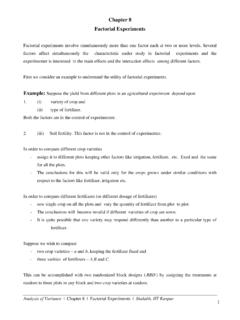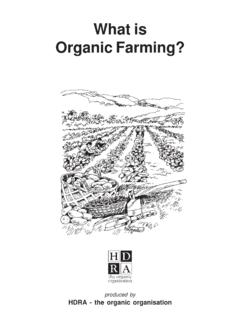Transcription of Potato and soil conservation - Food and Agriculture ...
1 International Year of the Potato 2008. Potato and soil conservation Potato cultivation usually involves with a green manure cover crop. The Mulch planting and the no- intensive soil tillage throughout the Potato is later planted into the beds till Potato can help reduce cropping period, which often leads to which, by then, are covered by the dead the soil degradation, soil degradation, erosion and leaching mulch of the manure crop. erosion and nitrate of nitrates. During soil preparation, the entire topsoil is loosened and - For mechanical planting, planters are pollution often associated particularly on sticky soils - pulverized equipped with special discs that cut with Potato production through the mulch and split the Potato into small aggregates to avoid the formation of clods in the Potato beds. beds. The mulch protects the soil from Mechanical weeding and mechanized erosion during the first weeks of the harvesting also involve intensive soil crop. As the Potato plants grow, the Key Points reshaping of the beds incorporates the movement.
2 conservation Agriculture a resource-saving crop production system mulch. A second green manure crop Land preparation, weeding and offers several useful techniques for soil can be seeded towards the end of harvesting of Potato often involve conservation in Potato production. the Potato crop, as the Potato plants intensive soil disturbance. are drying off. The cover crop helps to Mulch planting for potatoes dry out the Potato beds, contributing Cover crops sown before planting and as the crop matures protect the soil and In conventional, tillage-based Potato to healthier tubers with reduced risk facilitate harvesting. cropping systems, the risk of soil erosion of damage during harvest. The green and nitrate leaching can be reduced manure is separated from the Potato Cultivation of Potato without tillage helps using the mulch planting technique. by a mechanical Potato harvester and restore soil, produces good yields and The Potato beds are prepared well in is left as a mulch cover after harvest, reduces the need for fertilizer and fuel.
3 Advance of planting - if Potato is to be protecting the soil from erosion. planted in spring, the beds would be prepared before winter and seeded Mulch planting is being used for potatoes in parts of Germany and Switzerland, particularly in watersheds where drinking water sources might The advantages of conservation Agriculture be prone to nitrate pollution from conventional cultivation methods. Nevertheless, while mulch planting of potatoes reduces the risk of erosion and nitrate leaching, it still involves major soil movement. The no-till Potato '. Soil conservation can be enhanced further using a basic CA technique, no-till cultivation. The no-till Potato is pressed into the soil surface, then covered with a thick layer of mulch - conservation Agriculture (CA) aims at enhancing natural biological processes preferably straw, which is fairly stable both above and below ground. It is based on three principles: minimum and does not rot quickly. (Potatoes mechanical soil disturbance, permanent organic soil cover, and diversified need to be kept in the dark to avoid the crop rotations for annual crops and plant associations for perennial crops.)
4 Formation of chlorophyll, which renders By minimizing soil disturbance, CA creates a vertical macro-pore structure in the tubers green, bitter and toxic.). the soil, which facilitates the infiltration of excess rainwater into the subsoil, improves the aeration of deeper soil layers, and facilitates root penetration. In some cases - for example in dry No-till Potato in the Democratic People's Republic of Korea areas under drip irrigation - black plastic sheets can also be used as mulch. Holes are punched in the plastic to allow the Potato plant to grow through it. The young Potato tubers form under the mulch but above the soil surface. During harvesting, the sheets are removed and the potatoes are simply collected . Currently, the no-till . Potato is only grown in small fields using manual labour - for example, in Peru under plastic covers and in the Democratic People's Republic of Korea under rice straw. Farmers in the Democratic People's Republic of Korea are using conservation Agriculture in rice and Potato production in order to restore degraded soils and achieve good Potato yields with reduced need for fertilizer and fuel.
5 The Potato -rice crop rotation system produces two crops in a relatively short growing season, resulting in higher overall food production when compared to output from a single main crop. The seed Potato is inserted into the soil under a mulch cover formed by the residues of the preceding rice crop. The potatoes grow through the rice straw and are harvested within three months. Immediately afterward, no-till rice is transplanted as the main summer crop. Per hectare, the system can produce 25 tonnes of potatoes and tonnes of rice. and in cold storage and transport infrastructure. About IYP 2008 Contact: International Year of the Potato Secretariat The International Year of the Potato , Food and Agriculture Organization to be celebrated throughout 2008, of the United Nations aims at raising global awareness of Room C-776. the Potato 's key role in Agriculture , the Viale delle Terme di Caracalla economy and world food security. 00153 Rome, Italy Tel. + (39) 06 5705 5859, 06 5705 4233.
6 E-mail: Credits: Information provided by the FAO's Plant Production and Protection Division of FAO. Photos: FAO/T. Friedrich

















